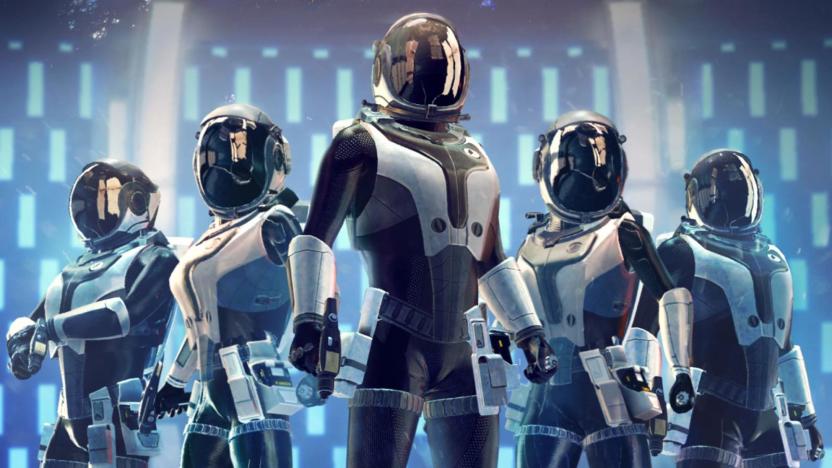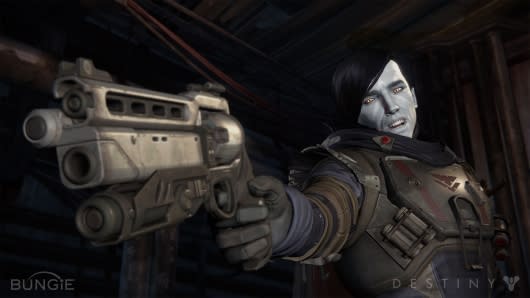motion capture
Latest

Sony steps into the Metaverse with the 'Mocopi' motion tracking system
Sony has launched an interesting product called Mocopi, consisting of six motion-tracking bands worn on your hands, feet, back and head.

Amazon hopes more robots will improve worker safety
Amazon has offered a look at robots it hopes will improve worker safety, although they raise questions about the company's other safety practices.

'Away Mission' is a free-roaming 'Star Trek' VR experience
When Starfleet calls, Trekkies will answer, and Starfleet's latest call to action involves the world's first free-roam Star Trek experience. Later this year Sandbox VR will launch the first Holodeck VR experience, where fans can enter the world of Star Trek to complete a mission involving problem-solving, combat and -- of course -- phasers.

ICYMI: Pot breathalyzer, VR for pharaoh's tomb and more
#fivemin-widget-blogsmith-image-979940{display:none;} .cke_show_borders #fivemin-widget-blogsmith-image-979940, #postcontentcontainer #fivemin-widget-blogsmith-image-979940{width:570px;display:block;} try{document.getElementById("fivemin-widget-blogsmith-image-979940").style.display="none";}catch(e){}Today on In Case You Missed It: A prototype marijuana breathalyzer came out and oh lord, the glory days are over. NASA's New Horizons spacecraft got the best ever photos of Pluto and these scientists are adorably jacked up about it. And a Swiss motion capture company wants to put sensors and VR headsets together in museum settings to let people explore an ancient Egyptian tomb.

Motion-sensing 'PomPom Mirror' recreates your likeness in fur
If you're tired of your ugly mug staring back from across the bathroom sink every morning, just install this furry silhouetting mirror from New York-based artist Daniel Rozin. He built it for the Descent With Modification exhibit at NYC's bitforms gallery. The "PomPom Mirror," as it's called, leverages a Kinect motion capture device to control 464 servos that, in turn, flip 928 black and white faux fur pom poms back and forth to match your movements in real-time.

How I turned my Xbox's Kinect into a wondrous motion-capture device
When Microsoft started selling a basic Xbox One package without a Kinect V2 for $100 less, the result was unequivocal: Sales took off. Most gamers can take or leave the ubiquitous depth camera, because it just isn't as useful for gaming as, say, the Wii controller. It is indispensable for certain titles, like Just Dance 2014, Xbox Fitness and Fighter Within. Others, such as Madden NFL 25 and Battlefield 4, can make use of the Kinect 2, but absolutely don't need it. In other words, it's a big bag of meh for gamers and casual users. But recently, my ears perked up when Microsoft released a $50 cable that lets you use the Xbox One's Kinect on a PC.

What you need to know about 3D motion capture
Close your eyes and go back... back in time. Picture Jar Jar Binks or Polar Express, movies that put the "Uncanny Valley" on the map. I know these aren't pleasant memories, but new technology like motion capture (mocap) can be... awkward in its youth. Now, let's forget all that and move forward to a time when the tech started hitting its stride -- from Lord of the Rings' Gollum to Avatar to The Avengers' Hulk. And let's not forget games -- The Last of Us has some of the best mocap done in any medium and Electronic Arts has used the technique since Madden NFL '94. But what is mocap, exactly, and how is it done? Will it ever replace live actors or put 3D animators out of business? To answer all that, let's head back in time 100 years.

Destiny to use facial motion capture
It's time for Destiny's close-up! The upcoming MMO is paying attention to more than just scenery and armor models, as Bungie has hired Faceware Technologies to provide facial motion capture for the game's characters. Faceware Technologies uses a "markerless" motion capture system to quickly scan and analyze actors' faces and record those expressions. Destiny artists can then take those expressions and put them on the game's models. Bungie previously worked with Faceware on Halo: Reach. You can read the full press release after the break.

Star Citizen tops $10 million, mocap studio a go
It's a good day to be Chris Roberts or one of the Cloud Imperium game developers working on Star Citizen. The upcoming space sim sandbox finally conquered the $10 million crowdfunding summit earlier this afternoon, and as a result, CIG will build its own motion capture studio. "We hit the unbelievable mark of ten million dollars and, as promised, we're adding an Optitrack motion capture system to our production pipeline in order to build the best, most immersive gaming experience that only a PC game can deliver," says the entry on CIG's YouTube portal. Head past the break for a video message from Roberts and a sneak peek at the Optitrack tech.

See Watch Dogs mocap actors jump down some dubsteps
This latest development diary for Ubisoft's current/next-gen hacking/big-brother simulator Watch Dogs focuses on the complex motion capture work that is being done on the game's main character, as well as the various people he brutally assaults while reading their private Facebook messages.

The Last of Us behind the scenes vid shows how mo-cap becomes final copy
This video for Naughty Dog's The Last of Us introduces the Tess character, played by Annie Wersching (Renee Walker in 24). It also neatly shows off the effects of what's required to get from motion-capture to final animation, and those bauble-dotted mo-cap suits which are always fun. %Gallery-173446%

The Last of Us and the process of creating a cutscene
It's quite the process to create a cutscene in The Last of Us – from the animators to the actors doing the motion-capture to the end result in-game, it takes a lot of effort. Developer Naughty Dog has given us a behind-the-scenes look at how one scene in particular was made, which is, to be quite frank, equal parts fascinating and daunting. But, hey, if all this insight isn't your thing, then at least you get to watch people run around in funny suits. There's got to be some value in that, right?

Microsoft patent applications take Kinect into mobile cameras, movie-making
Microsoft has never been shy about its ambitions for Kinect's depth sensing abilities. A pair of patent applications, however, show that its hopes and dreams are taking a more Hollywood turn. One patent has the depth camera going portable: a "mobile environment sensor" determines its trajectory through a room and generates a depth map as it goes, whether it's using a Kinect-style infrared sensor or stereoscopic cameras. If the visual mapping isn't enough, the would-be camera relies on a motion sensor like an accelerometer to better judge its position as it's jostled around. Microsoft doesn't want to suggest what kind of device (if any) might use the patent for its camera, but it's not ruling out anything from smartphones through to traditional PCs. The second patent filing uses the Kinect already in the house for that directorial debut you've always been putting off. Hand gestures control the movie editing, but the depth camera both generates a model of the environment and creates 3D props out of real objects. Motion capture, naturally, lets the humans in the scene pursue their own short-lived acting careers. We haven't seen any immediate signs that Microsoft is planning to use this or the mobile sensor patent filing in the real world, although both are closer to reality than some of the flights of fancy that pass by the USPTO -- the movie editor has all the hallmarks of a potential Dashboard update or Kinect Fun Labs project.

Behind the scenes of Quantic Dream's 'Kara' tech demo
Have you thought about just how Quantic Dream pulled off that "Kara" tech demo on the PS3? If your answer, like ours, was that they actually built a female android and taught it how to speak all those languages and sing, then you're wrong. They didn't do that at all. Female androids don't exist in real life. Sigh.No, instead they hired an actress named Valorie Curry (actually three different women -- Curry for acting, one for the German and French, and another to sing) to come in and do motion capture for the part, and refined and developed her performance over a series of about eight months before finally capturing it for the tech demo.You can see the whole process in the video above, and watch the original tech demo below. Yeah, we guess it's cool and all that they put so much care and work into such a quality video -- but not as cool as a real female android. Sigh again.

Heavy Rain creators produce 'Kara' PS3 tech-demo (video)
Heavy Rain creator David Cage was showing off Quantic Dream's new game engine at GDC, which includes an innovative new performance-capture technology the company's developed. He's directed a seven-minute original short called Kara, which is the story of a female android as she becomes self-aware. Unlike traditional game production methods, this technology is able to record face and body movements at the same time as recording the actors voice -- ensuring natural and consistent performances from the characters. Actress Valorie Curry wore 90 sensors on her face, unlike in, say, Avatar, where the performers wore head-mounted cameras. Cage promises that the short is nothing more than a demo (it was rendered in real-time on a PlayStation 3) and none of these elements will appear in his next game. You can catch the impressive-looking footage after the break with one disclaimer: there's nudity throughout and a reference to adult themes, okay?

Guild Wars 2 developer explains updated cinematic conversations
Guild Wars 2 fans are starting their morning with an interesting update and some entertainment, thanks to ArenaNet's motion capture and cinematic guru Chuck Jackman. Chuck is the mind behind the newest ArenaNet blog entry, all about the recent improvements to Guild Wars 2's cinematic conversations. The cinematic conversations in Guild Wars 2 are the brief cutscenes that take place between player characters and NPCs at significant points in the story line. Until now, players trying the demo have only seen the placeholder versions of these cinematics, which consisted of a lot of seemingly-random emotes and what Chuck describes as "some very basic lip-synch that resembled more of a duck's bill than a human's mouth." The team has been hard at work on improvements, though, and today's blog entry unveiled two videos of the new cinematics. It's a fairly lengthy read, with plenty of explanation of everything from emotes to facial animations to voice work. If your eyes glaze over at even a hint of tech-speak, fear not. While we have our doubts about Chuck's claims of blotting out the sun and tearing code from the minds of ancient gods, it's definitely an entertaining and informative read for any gaming fan. Check out the full entry at the ArenaNet blog.

Watch the actors of Uncharted 3 get their motions captured
How are the character animations of Uncharted 3: Drake's Deception so darn lifelike? It's because they're the movements of real human beings, captured through some sort of ... witchcraft. Watch the video above to see this occult practice in action.

Hey yo, T(ether) technology tracks rap gestures in 3D
T(ether) is a bit like that amazing Reality Fighters game we saw on the PS Vita, except it's more tranquil and it works slightly differently. The tablet-based technology uses motion capture cameras to track users' heads and the orientation of the device itself, building a 1:1 spatial connection between real and virtual coordinates and allowing "intuitive interaction with volumetric data." As you'll see in the clip after the break, this equates to some pretty neat tricks. And, if you throw in multiple users wearing motion-tracked gloves, things get even more Eastside.

Researchers demo 3D face scanning breakthroughs at SIGGRAPH, Kinect crowd squarely targeted
Lookin' to get your Grown Nerd on? Look no further. We just sat through 1.5 hours of high-brow technobabble here at SIGGRAPH 2011, where a gaggle of gurus with IQs far, far higher than ours explained in detail what the future of 3D face scanning would hold. Scientists from ETH Zürich, Texas A&M, Technion-Israel Institute of Technology, Carnegie Mellon University as well as a variety of folks from Microsoft Research and Disney Research labs were on hand, with each subset revealing a slightly different technique to solving an all-too-similar problem: painfully accurate 3D face tracking. Haoda Huang et al. revealed a highly technical new method that involved the combination of marker-based motion capture with 3D scanning in an effort to overcome drift, while Thabo Beeler et al. took a drastically different approach. Those folks relied on a markerless system that used a well-lit, multi-camera system to overcome occlusion, with anchor frames acting as staples in the success of its capture abilities. J. Rafael Tena et al. developed "a method that not only translates the motions of actors into a three-dimensional face model, but also subdivides it into facial regions that enable animators to intuitively create the poses they need." Naturally, this one's most useful for animators and designers, but the first system detailed is obviously gunning to work on lower-cost devices -- Microsoft's Kinect was specifically mentioned, and it doesn't take a seasoned imagination to see how in-home facial scanning could lead to far more interactive games and augmented reality sessions. The full shebang can be grokked by diving into the links below, but we'd advise you to set aside a few hours (and rest up beforehand). %Gallery-130390%

Organic Motion's OpenStage motion capture system grabs 200FPS, no backdrop required (video)
At just under $40,000 for an eight camera setup, we're hardly in hobbyist territory here, but Organic Motion's new OpenStage 2.0 motion capture system could certainly make do in the average basement. Unlike a few competing solutions shown here at SIGGRAPH, this one actually has no backdrop mandate, and better still, doesn't require you to latch a single sensor onto your subject. The magic lies within the cameras hung above -- kits are sold that contain between eight and 24 cameras, and even the latter can be handled with a single workstation. Multi-person tracking ain't no thang, and while you aren't capturing HD footage here, the high-speed VGA capability enables up to 200 frames per second to be logged. Not surprisingly, the company's aiming this squarely at the animation and medical realms, and should start shipping bundles as early as next month. Looking to take down Pixar? You'll need a lot more than 40 large, but perhaps the video after the break will give you a bit of inspiration. %Gallery-130288%















